Lower Carbon Footprint Concrete Using Recycled Carbon Fiber for Targeted Strength and Insulation
Abstract
:1. Introduction
1.1. Overview: Fiber-Reinforced Ultra-Lightweight, Structural Lightweight, and High-Strength Concrete
1.2. Carbon Fiber and Recycled Carbon Fiber Overview
1.3. Micro X-ray Computed (µ-XCT) and Thermal Conductivity of Concrete Mix Designs
1.4. Significance of This Study
2. Materials and Methods
2.1. Experimental Program for the Concrete Mix Designs
2.2. Fiber Properties
2.3. Scanning Electron Microscopy and Energy Dispersive X-ray Spectroscopy of Fibers
2.4. Wide Angle X-ray Scattering of Carbon Fiber
2.5. High-Strength and Lightweight Concrete Mix Designs
2.6. Concrete Mixing Procedure
2.7. Casting Samples
2.8. Mechanical Testing of Casted Samples
2.9. Micro X-ray Computed Tomography
2.10. Thermal Conductivity
2.11. Statistical Analysis
3. Results
3.1. Scanning Electron Microscopy and Element Chemical Composition of Fibers
3.2. Wide Angle X-ray Scattering of Carbon fibers
3.3. Mechanical Properties of the Fiber-Reinforced Concrete Mix Designs
3.4. Micro X-ray Computed Tomography
3.5. Thermal Conductivity of Fiber-Reinforcement Concrete Mix Designs
3.6. Scanning Electron Microscopy of Failed Concrete Mix Designs
4. Discussion
5. Conclusions
- Incorporation of recycled carbon fibers into the three concrete types can increase the tensile and flexural strength of neat concrete.
- The recycled carbon-fiber-reinforced concrete has slightly higher ductility compared to the neat concrete for tension and flexural strength but lower than the steel-fiber-reinforced concrete mix designs.
- The recycled carbon fibers tended to increase the void content in the concrete, with the exception of the ultra-light mix where the fibers constrained the aggregates and allowed for their more uniform dispersion.
- An increase in void volume content is the primary factor affecting the decrease in thermal conductivity for the concrete mix designs.
- The addition of fibers increases the thermal conductivity of the concrete; however, the additional voids caused by the fibers can negate the effects.
Author Contributions
Funding
Institutional Review Board Statement
Data Availability Statement
Acknowledgments
Conflicts of Interest
References
- Naganna, S.R.; Ibrahim, H.A.; Yap, S.P.; Tan, C.G.; Mo, K.H.; El-Shafie, A. Insights into the Multifaceted Applications of Architectural Concrete: A State-of-the-Art Review. Arab. J. Sci. Eng. 2021, 46, 4213–4223. [Google Scholar] [CrossRef]
- ACI CODE-318-19; Building Code Requirements for Structural Concrete and Commentary. Americal Concrete Institute: Farmington Hills, MI, USA, 2019.
- Breveglieri, M.; Czaderski, C. Reinforced concrete slabs strengthened with externally bonded carbon fibre-reinforced polymer strips under long-term environmental exposure and sustained loading. Part 1: Outdoor experiments. Compos. Part C Open Access 2022, 7, 100239. [Google Scholar] [CrossRef]
- Bonopera, M.; Liao, W.-C.; Perceka, W. Experimental–theoretical investigation of the short-term vibration response of uncracked prestressed concrete members under long-age conditions. Structures 2022, 35, 260–273. [Google Scholar] [CrossRef]
- U.S. Geological Survey. Mineral Commodity Summaries 2022; U.S. Geological Survey: Reston, VA, USA, 2022; p. 202. [Google Scholar]
- Koksal, F.; Gencel, O.; Kaya, M. Combined effect of silica fume and expanded vermiculite on properties of lightweight mortars at ambient and elevated temperatures. Constr. Build. Mater. 2015, 88, 175–187. [Google Scholar] [CrossRef]
- Mo, K.H.; Ling, T.-C.; Alengaram, U.J.; Yap, S.P.; Yuen, C.W. Overview of supplementary cementitious materials usage in lightweight aggregate concrete. Constr. Build. Mater. 2017, 139, 403–418. [Google Scholar] [CrossRef]
- Hooton, R.D.; Bickley, J.A. Design for durability: The key to improving concrete sustainability. Constr. Build. Mater. 2014, 67, 422–430. [Google Scholar] [CrossRef]
- Zhang, B.; Feng, Y.; Xie, J.; He, J.; Zhang, Y.; Cai, C.; Huang, D.; Li, L. Effects of fibres on ultra-lightweight high strength concrete: Dynamic behaviour and microstructures. Cem. Concr. Compos. 2022, 128, 104417. [Google Scholar] [CrossRef]
- Younis, A.; El-Sherif, H.; Ebead, U. Shear strength of recycled-aggregate concrete beams with glass-FRP stirrups. Compos. Part C Open Access 2022, 8, 100257. [Google Scholar] [CrossRef]
- Sharifikolouei, E.; Canonico, F.; Salvo, M.; Baino, F.; Ferraris, M. Vitrified and nonvitrified municipal solid wastes as ordinary Portland cement (OPC) and sand substitution in mortars. Int. J. Appl. Ceram. Technol. 2019, 17, 573–583. [Google Scholar] [CrossRef]
- Karaki, A.; Mohammad, M.; Masad, E.; Khraisheh, M. Theoretical and computational modeling of thermal properties of lightweight concrete. Case Stud. Therm. Eng. 2021, 28, 101683. [Google Scholar] [CrossRef]
- Chung, S.-Y.; Han, T.-S.; Kim, S.-Y.; Jay Kim, J.-H.; Youm, K.S.; Lim, J.-H. Evaluation of effect of glass beads on thermal conductivity of insulating concrete using micro CT images and probability functions. Cem. Concr. Compos. 2016, 65, 150–162. [Google Scholar] [CrossRef]
- Asadi, I.; Shafigh, P.; Abu Hassan, Z.F.B.; Mahyuddin, N.B. Thermal conductivity of concrete—A review. J. Build. Eng. 2018, 20, 81–93. [Google Scholar] [CrossRef]
- Real, S.; Gomes, M.G.; Moret Rodrigues, A.; Bogas, J.A. Contribution of structural lightweight aggregate concrete to the reduction of thermal bridging effect in buildings. Constr. Build. Mater. 2016, 121, 460–470. [Google Scholar] [CrossRef]
- Del Coz Díaz, J.J.; García Nieto, P.J.; Domínguez Hernández, J.; Suárez Sánchez, A. Thermal design optimization of lightweight concrete blocks for internal one-way spanning slabs floors by FEM. Energy Build. 2009, 41, 1276–1287. [Google Scholar] [CrossRef]
- Cavalline, T.L.; Gallegos, J.; Castrodale, R.W.; Freeman, C.; Liner, J.; Wall, J. Influence of Lightweight Aggregate Concrete Materials on Building Energy Performance. Buildings 2021, 11, 94. [Google Scholar] [CrossRef]
- Schackow, A.; Effting, C.; Folgueras, M.V.; Güths, S.; Mendes, G.A. Mechanical and thermal properties of lightweight concretes with vermiculite and EPS using air-entraining agent. Constr. Build. Mater. 2014, 57, 190–197. [Google Scholar] [CrossRef]
- Glenn, G.M.; Klamczynski, A.K.; Chiou, B.-S.; Wood, D.; Orts, W.J.; Imam, S.H. Lightweight Concrete Containing an Alkaline Resistant Starch-Based Aquagel. J. Polym. Environ. 2004, 12, 189–196. [Google Scholar] [CrossRef]
- Clarke, J.L. Structural Lightweight Aggregate Concrete; CRC Press: Boca Raton, FL, USA, 1993. [Google Scholar]
- Lawson, R. Fire resistance of ribbed concrete and composite slabs. Concrete 1987, 21, 18–20. [Google Scholar]
- Thienel, C.; Peck, M. Die Renaissance leichter Betone in der Architektur. Detail 2007, 47, 522–534. [Google Scholar]
- Thienel, K.-C.; Haller, T.; Beuntner, N. Lightweight Concrete—From Basics to Innovations. Materials 2020, 13, 1120. [Google Scholar] [CrossRef] [Green Version]
- Akers, D.J.; Gruber, R.D.; Ramme, B.W.; Boyle, M.J.; Grygar, J.G.; Rowe, S.K.; Bremner, T.W.; Kluckowski, E.S.; Sheetz, S.R.; Burg, R.G. Guide for Structural Lightweight-Aggregate Concrete; ACI 213R-03; Americal Concrete Institute: Farmington Hills, MI, USA, 2003. [Google Scholar]
- Yu, Q.L.; Spiesz, P.; Brouwers, H.J.H. Ultra-lightweight concrete: Conceptual design and performance evaluation. Cem. Concr. Compos. 2015, 61, 18–28. [Google Scholar] [CrossRef]
- Zhao, S.; Ding, X.; Zhao, M.; Li, C.; Pei, S. Experimental study on tensile strength development of concrete with manufactured sand. Constr. Build. Mater. 2017, 138, 247–253. [Google Scholar] [CrossRef]
- Altuki, R.; Tyler Ley, M.; Cook, D.; Jagan Gudimettla, M.; Praul, M. Increasing sustainable aggregate usage in concrete by quantifying the shape and gradation of manufactured sand. Constr. Build. Mater. 2022, 321, 125593. [Google Scholar] [CrossRef]
- Kiran, T.; Yadav, S.K.; Anand, N.; Mathews, M.E.; Andrushia, D.; Lubloy, E.; Kodur, V. Performance evaluation of lightweight insulating plaster for enhancing the fire endurance of high strength structural concrete. J. Build. Eng. 2022, 57, 104902. [Google Scholar] [CrossRef]
- Wu, T.; Yang, X.; Wei, H.; Liu, X. Mechanical properties and microstructure of lightweight aggregate concrete with and without fibers. Constr. Build. Mater. 2019, 199, 526–539. [Google Scholar] [CrossRef]
- Kosmatka, S.H.; Panarese, W.C.; Kerkhoff, B. Design and Control of Concrete Mixtures; Portland Cement Association: Skokie, IL, USA, 2002; Volume 5420. [Google Scholar]
- Lab, R.H. Think Formwork—Reduce Costs. Structure, April 2007. [Google Scholar]
- Bertolini, L.; Elsener, B.; Pedeferri, P.; Redaelli, E.; Polder, R.B. Corrosion of Steel in Concrete: Prevention, Diagnosis, Repair; John Wiley & Sons: Hoboken, NJ, USA, 2013. [Google Scholar]
- Shi, X.; Xie, N.; Fortune, K.; Gong, J. Durability of steel reinforced concrete in chloride environments: An overview. Constr. Build. Mater. 2012, 30, 125–138. [Google Scholar] [CrossRef]
- Samples, L.M.; Ramirez, J.A. Methods of Corrosion Protection and Durability of Concrete Bridge Decks Reinforced with Epoxy-Coated Bars—Phase I; Indiana Department of Transportation and Purdue University: West Lafayette, IN, USA, 1999. [Google Scholar]
- Yan, D.; Qian, H.; Xu, Z.; Chen, S.; Chen, G. Microstructural and mechanical characterization of the interface between concrete and chemically reactive enamel (CRE) coated rebar. Constr. Build. Mater. 2020, 263, 120676. [Google Scholar] [CrossRef]
- Di Franco, F.; Zaffora, A.; Megna, B.; Santamaria, M. Heterogeneous crystallization of zinc hydroxystannate on galvanized steel for enhancing the bond strength at the rebar/concrete interface. Chem. Eng. J. 2021, 405, 126943. [Google Scholar] [CrossRef]
- Merli, R.; Preziosi, M.; Acampora, A.; Lucchetti, M.C.; Petrucci, E. Recycled fibers in reinforced concrete: A systematic literature review. J. Clean. Prod. 2020, 248, 119207. [Google Scholar] [CrossRef]
- Al-Kharabsheh, B.N.; Arbili, M.M.; Majdi, A.; Alogla, S.M.; Hakamy, A.; Ahmad, J.; Deifalla, A.F. Basalt Fiber Reinforced Concrete: A Compressive Review on Durability Aspects. Materials 2023, 16, 429. [Google Scholar] [CrossRef]
- De Carvalho Bello, C.B.; Cecchi, A. Experiments on natural fibers: Durability and mechanical properties. Adv. Mater. Process. Technol. 2017, 3, 632–639. [Google Scholar] [CrossRef]
- Baraldi, D.; Boscato, G.; Cecchi, A.; de Carvalho Bello, C.B. An Updated Discrete Element Model for the In-Plane Behaviour of NFRCM Strengthed Masonry Walls. Key Eng. Mater. 2022, 916, 249–255. [Google Scholar] [CrossRef]
- Banthia, N.; Sappakittipakorn, M. Toughness enhancement in steel fiber reinforced concrete through fiber hybridization. Cem. Concr. Res. 2007, 37, 1366–1372. [Google Scholar] [CrossRef]
- Di Prisco, M.; Plizzari, G.; Vandewalle, L. Fibre reinforced concrete: New design perspectives. Mater. Struct. 2009, 42, 1261–1281. [Google Scholar] [CrossRef]
- Ghanem, S.Y.; Bowling, J.; Sun, Z. Mechanical Properties of Hybrid Synthetic Fiber Reinforced Self- Consolidating Concrete. Compos. Part C Open Access 2021, 5, 100154. [Google Scholar] [CrossRef]
- Song, P.S.; Wu, J.C.; Hwang, S.; Sheu, B.C. Assessment of statistical variations in impact resistance of high-strength concrete and high-strength steel fiber-reinforced concrete. Cem. Concr. Res. 2005, 35, 393–399. [Google Scholar] [CrossRef]
- Betterman, L.R.; Ouyang, C.; Shah, S.P. Fiber-matrix interaction in microfiber-reinforced mortar. Adv. Cem. Based Mater. 1995, 2, 53–61. [Google Scholar] [CrossRef]
- Brandt, A.M. Fibre reinforced cement-based (FRC) composites after over 40 years of development in building and civil engineering. Compos. Struct. 2008, 86, 3–9. [Google Scholar] [CrossRef]
- Rossi, P. Ultra-High Performance Fiber-Reinforced Concretes. Concr. Int. 2001, 23, 46–52. [Google Scholar]
- Afroughsabet, V.; Biolzi, L.; Ozbakkaloglu, T. High-performance fiber-reinforced concrete: A review. J. Mater. Sci. 2016, 51, 6517–6551. [Google Scholar] [CrossRef] [Green Version]
- Mehta, P.K.; Monteiro, P.J. Concrete: Microstructure, Properties, and Materials; McGraw-Hill Education: New York, NY, USA, 2014. [Google Scholar]
- Biolzi, L.; Cattaneo, S.; Guerrini, G.L. Fracture of Plain and Fiber-Reinforced High Strength Mortar Slabs with EA and ESPI Monitoring. Appl. Compos. Mater. 2000, 7, 1–12. [Google Scholar] [CrossRef]
- Zhou, H.; Jia, B.; Huang, H.; Mou, Y. Experimental Study on Basic Mechanical Properties of Basalt Fiber Reinforced Concrete. Materials 2020, 13, 1362. [Google Scholar] [CrossRef] [Green Version]
- Dvorkin, L.; Dvorkin, O. Basics of Concrete Science; Stroi-Beton: Saint Petersburg, Russia, 2006; p. 200. [Google Scholar]
- Barros, J.A.; Sena-Cruz, J. Fracture energy of steel fiber-reinforced concrete. Mech. Compos. Mater. Struct. 2001, 8, 29–45. [Google Scholar] [CrossRef]
- Mendis, P. Design of high-strength concrete members: State-of-the-art. Prog. Struct. Eng. Mater. 2003, 5, 1–15. [Google Scholar] [CrossRef]
- Shah, S.P.; Ahmad, S.H. High Performance Concrete: Properties and Applications; McGraw-Hill: New York, NY, USA, 1994. [Google Scholar]
- Malier, Y. High Performance Concrete: From Material to Structure; CRC Press: Boca Raton, FL, USA, 1992. [Google Scholar]
- Gjørv, O. High-strength concrete. In Developments in the Formulation and Reinforcement of Concrete; Elsevier: Amsterdam, The Netherlands, 2008; pp. 153–170. [Google Scholar]
- Mendis, P.; Pendyala, R. High-strength/High-performance Concrete in Australia-Design and Applications. In Proceedings of the 4th World Conference on Utilization of High-Strength/High-Performance Concrete, Paris, France, 29–31 May 1996; pp. 1581–1590. [Google Scholar]
- Chang, P.-K.; Hwang, C.-L.; Peng, Y.-N. Application of High-Performance Concrete to High-Rise Building in Taiwan. Adv. Struct. Eng. 2001, 4, 65–73. [Google Scholar] [CrossRef]
- French, C.; Mokhtarzadeh, A.; Ahlborn, T.; Leon, R. High-strength concrete applications to prestressed bridge girders. Constr. Build. Mater. 1998, 12, 105–113. [Google Scholar] [CrossRef]
- Persson, B.S.; Johansson, A.G.; Johansson, P.S. Prefabrication with HSC. Concr. Int. 1999, 21, 58–62. [Google Scholar]
- Thornton, C.H.; Mohamad, H.; Hungspruke, U.; Joseph, L.M.; Hashimah, H. The Petronas Twin Towers and High-Performance Concrete. ACI Symp. Publ. 1999, 172, 329–350. [Google Scholar] [CrossRef]
- Tadros, M.K.; Huo, X.; Ma, Z.J.; Baishya, M. Structural Design of High-Performance Concrete Bridges. ACI Symp. Publ. 2000, 189, 9–36. [Google Scholar] [CrossRef]
- Breitenbucher, R. Developments and applications of high-performance concrete. Mater. Struct. 1998, 31, 209–215. [Google Scholar] [CrossRef]
- Balaguru, P.; Foden, A. Properties of Fiber Reinforced Structural Lightweight Concrete. ACI Struct. J. 1996, 93, 62–78. [Google Scholar] [CrossRef]
- Wang, J.-Y.; Chia, K.-S.; Liew, J.-Y.R.; Zhang, M.-H. Flexural performance of fiber-reinforced ultra lightweight cement composites with low fiber content. Cem. Concr. Compos. 2013, 43, 39–47. [Google Scholar] [CrossRef]
- Ohama, Y. Carbon-cement composites. Carbon 1989, 27, 729–737. [Google Scholar] [CrossRef]
- Ali, M.A.; Majumdar, A.J.; Rayment, D.L. Carbon fibre reinforcement of cement. Cem. Concr. Res. 1972, 2, 201–212. [Google Scholar] [CrossRef]
- Daniel, I.M.; Ishai, O.; Daniel, I.M.; Daniel, I. Engineering Mechanics of Composite Materials; Oxford University Press: New York, NY, USA, 2006; Volume 1994. [Google Scholar]
- Kizilkanat, A.B. Experimental Evaluation of Mechanical Properties and Fracture Behavior of Carbon Fiber Reinforced High Strength Concrete. Period. Polytech. Civ. Eng. 2016, 60, 289–296. [Google Scholar] [CrossRef] [Green Version]
- Chen, B.; Liu, J. Contribution of hybrid fibers on the properties of the high-strength lightweight concrete having good workability. Cem. Concr. Res. 2005, 35, 913–917. [Google Scholar] [CrossRef]
- Isa, M.N.; Pilakoutas, K.; Guadagnini, M.; Angelakopoulos, H. Mechanical performance of affordable and eco-efficient ultra-high performance concrete (UHPC) containing recycled tyre steel fibres. Constr. Build. Mater. 2020, 255, 119272. [Google Scholar] [CrossRef]
- Zhong, R.; Wille, K.; Viegas, R. Material efficiency in the design of UHPC paste from a life cycle point of view. Constr. Build. Mater. 2018, 160, 505–513. [Google Scholar] [CrossRef]
- Das, S. Life cycle assessment of carbon fiber-reinforced polymer composites. Int. J. Life Cycle Assess. 2011, 16, 268–282. [Google Scholar] [CrossRef]
- Van de Werken, N.; Reese, M.S.; Taha, M.R.; Tehrani, M. Investigating the effects of fiber surface treatment and alignment on mechanical properties of recycled carbon fiber composites. Compos. Part A Appl. Sci. Manuf. 2019, 119, 38–47. [Google Scholar] [CrossRef]
- Pimenta, S.; Pinho, S.T. Recycling carbon fibre reinforced polymers for structural applications: Technology review and market outlook. Waste Manag. 2011, 31, 378–392. [Google Scholar] [CrossRef] [Green Version]
- Butenegro, J.A.; Bahrami, M.; Abenojar, J.; Martínez, M.Á. Recent Progress in Carbon Fiber Reinforced Polymers Recycling: A Review of Recycling Methods and Reuse of Carbon Fibers. Materials 2021, 14, 6401. [Google Scholar] [CrossRef] [PubMed]
- Ary Subagia, I.D.G.; Kim, Y.; Tijing, L.D.; Kim, C.S.; Shon, H.K. Effect of stacking sequence on the flexural properties of hybrid composites reinforced with carbon and basalt fibers. Compos. Part B Eng. 2014, 58, 251–258. [Google Scholar] [CrossRef]
- Mainka, H.; Täger, O.; Körner, E.; Hilfert, L.; Busse, S.; Edelmann, F.T.; Herrmann, A.S. Lignin—An alternative precursor for sustainable and cost-effective automotive carbon fiber. J. Mater. Res. Technol. 2015, 4, 283–296. [Google Scholar] [CrossRef] [Green Version]
- Hassan, M.M.; Schiermeister, L.; Staiger, M.P. Sustainable Production of Carbon Fiber: Effect of Cross-Linking in Wool Fiber on Carbon Yields and Morphologies of Derived Carbon Fiber. ACS Sustain. Chem. Eng. 2015, 3, 2660–2668. [Google Scholar] [CrossRef]
- Ghosh, T.; Kim, H.C.; De Kleine, R.; Wallington, T.J.; Bakshi, B.R. Life cycle energy and greenhouse gas emissions implications of using carbon fiber reinforced polymers in automotive components: Front subframe case study. Sustain. Mater. Technol. 2021, 28, e00263. [Google Scholar] [CrossRef]
- Danish, A.; Mosaberpanah, M.A.; Salim, M.U.; Amran, M.; Fediuk, R.; Ozbakkaloglu, T.; Rashid, M.F. Utilization of recycled carbon fiber reinforced polymer in cementitious composites: A critical review. J. Build. Eng. 2022, 53, 104583. [Google Scholar] [CrossRef]
- Mohamed Sultan, A.A.; Mativenga, P.T. Sustainable Location Identification Decision Protocol (SuLIDeP) for determining the location of recycling centres in a circular economy. J. Clean. Prod. 2019, 223, 508–521. [Google Scholar] [CrossRef]
- Akbar, A.; Kodur, V.K.R.; Liew, K.M. Microstructural changes and mechanical performance of cement composites reinforced with recycled carbon fibers. Cem. Concr. Compos. 2021, 121, 104069. [Google Scholar] [CrossRef]
- Howarth, J.; Mareddy, S.S.R.; Mativenga, P.T. Energy intensity and environmental analysis of mechanical recycling of carbon fibre composite. J. Clean. Prod. 2014, 81, 46–50. [Google Scholar] [CrossRef]
- Karuppannan Gopalraj, S.; Kärki, T. A review on the recycling of waste carbon fibre/glass fibre-reinforced composites: Fibre recovery, properties and life-cycle analysis. SN Appl. Sci. 2020, 2, 433. [Google Scholar] [CrossRef] [Green Version]
- Hadigheh, S.A.; Wei, Y.; Kashi, S. Optimisation of CFRP composite recycling process based on energy consumption, kinetic behaviour and thermal degradation mechanism of recycled carbon fibre. J. Clean. Prod. 2021, 292, 125994. [Google Scholar] [CrossRef]
- Pickering, S.; Turner, T.; Meng, F.; Morris, C.; Heil, J.; Wong, K.; Melendi-Espina, S. Developments in the fluidised bed process for fibre recovery from thermoset composites. In Proceedings of the 2nd Annual Composites and Advanced Materials Expo, CAMX 2015, Dallas, TX, USA, 27–29 October 2015; Dallas Convention Center: Dallas, TX, USA, 2015; pp. 2384–2394. [Google Scholar]
- Pimenta, S.; Pinho, S.T.; Robinson, P.; Wong, K.H.; Pickering, S.J. Mechanical analysis and toughening mechanisms of a multiphase recycled CFRP. Compos. Sci. Technol. 2010, 70, 1713–1725. [Google Scholar] [CrossRef] [Green Version]
- Zhu, J.-H.; Chen, P.-y.; Su, M.-n.; Pei, C.; Xing, F. Recycling of carbon fibre reinforced plastics by electrically driven heterogeneous catalytic degradation of epoxy resin. Green Chem. 2019, 21, 1635–1647. [Google Scholar] [CrossRef] [Green Version]
- Kumar, S.; Krishnan, S. Recycling of carbon fiber with epoxy composites by chemical recycling for future perspective: A review. Chem. Pap. 2020, 74, 3785–3807. [Google Scholar] [CrossRef]
- Verma, S.; Balasubramaniam, B.; Gupta, R.K. Recycling, reclamation and re-manufacturing of carbon fibres. Curr. Opin. Green Sustain. Chem. 2018, 13, 86–90. [Google Scholar] [CrossRef]
- Bledzki, A.K.; Seidlitz, H.; Krenz, J.; Goracy, K.; Urbaniak, M.; Rösch, J.J. Recycling of Carbon Fiber Reinforced Composite Polymers—Review—Part 2: Recovery and Application of Recycled Carbon Fibers. Polymers 2020, 12, 3003. [Google Scholar] [CrossRef] [PubMed]
- Ma, C.; Sánchez-Rodríguez, D.; Kamo, T. Influence of thermal treatment on the properties of carbon fiber reinforced plastics under various conditions. Polym. Degrad. Stab. 2020, 178, 109199. [Google Scholar] [CrossRef]
- Karuppannan Gopalraj, S.; Kärki, T. A Study to Investigate the Mechanical Properties of Recycled Carbon Fibre/Glass Fibre-Reinforced Epoxy Composites Using a Novel Thermal Recycling Process. Processes 2020, 8, 954. [Google Scholar] [CrossRef]
- Sun, H.; Guo, G.; Memon, S.A.; Xu, W.; Zhang, Q.; Zhu, J.-H.; Xing, F. Recycling of carbon fibers from carbon fiber reinforced polymer using electrochemical method. Compos. Part A Appl. Sci. Manuf. 2015, 78, 10–17. [Google Scholar] [CrossRef]
- Nahil, M.A.; Williams, P.T. Recycling of carbon fibre reinforced polymeric waste for the production of activated carbon fibres. J. Anal. Appl. Pyrolysis 2011, 91, 67–75. [Google Scholar] [CrossRef]
- Das, M.; Chacko, R.; Varughese, S. An efficient method of recycling of CFRP waste using peracetic acid. ACS Sustain. Chem. Eng. 2018, 6, 1564–1571. [Google Scholar] [CrossRef]
- Ma, Y.; Nutt, S. Chemical treatment for recycling of amine/epoxy composites at atmospheric pressure. Polym. Degrad. Stab. 2018, 153, 307–317. [Google Scholar] [CrossRef]
- Ogi, K.; Shinoda, T.; Mizui, M. Strength in concrete reinforced with recycled CFRP pieces. Compos. Part A Appl. Sci. Manuf. 2005, 36, 893–902. [Google Scholar] [CrossRef]
- Mastali, M.; Dalvand, A. The impact resistance and mechanical properties of self-compacting concrete reinforced with recycled CFRP pieces. Compos. Part B Eng. 2016, 92, 360–376. [Google Scholar] [CrossRef]
- Mastali, M.; Dalvand, A.; Sattarifard, A. The impact resistance and mechanical properties of the reinforced self-compacting concrete incorporating recycled CFRP fiber with different lengths and dosages. Compos. Part B Eng. 2017, 112, 74–92. [Google Scholar] [CrossRef]
- Akbar, A.; Liew, K.M. Influence of elevated temperature on the microstructure and mechanical performance of cement composites reinforced with recycled carbon fibers. Compos. Part B Eng. 2020, 198, 108245. [Google Scholar] [CrossRef]
- Wang, Y.; Zhang, S.; Luo, D.; Shi, X. Effect of chemically modified recycled carbon fiber composite on the mechanical properties of cementitious mortar. Compos. Part B Eng. 2019, 173, 106853. [Google Scholar] [CrossRef]
- Liew, K.M.; Pan, Z.; Zhang, L.-W. The recent progress of functionally graded CNT reinforced composites and structures. Sci. China Phys. Mech. Astron. 2019, 63, 234601. [Google Scholar] [CrossRef] [Green Version]
- Meek, N.; Penumadu, D. Nonlinear elastic response of pan based carbon fiber to tensile loading and relations to microstructure. Carbon 2021, 178, 133–143. [Google Scholar] [CrossRef]
- Voet, A.; Morawski, J.-C.; Donnet, J.-B. Dynamic mechanical properties of carbon fibers. Carbon 1975, 13, 465–468. [Google Scholar] [CrossRef]
- Paulauskas, F.L.; White, T.L.; Spruiell, J.E. Structure and Properties of Carbon Fibers Produced Using Microwave-Assisted Plasma Technology, Part 2; Society for the Advancement of Material and Process Engineering (SAMPE): Diamond Bar, CA, USA, 2006. [Google Scholar]
- Lu, H.; Alymov, E.; Shah, S.; Peterson, K. Measurement of air void system in lightweight concrete by X-ray computed tomography. Constr. Build. Mater. 2017, 152, 467–483. [Google Scholar] [CrossRef]
- Mohammad, M.; Masad, E.; Seers, T.; Al-Ghamdi, S.G. Properties and Microstructure Distribution of High-Performance Thermal Insulation Concrete. Materials 2020, 13, 2091. [Google Scholar] [CrossRef]
- Patchen, A.; Young, S.; Penumadu, D. An Investigation of Mechanical Properties of Recycled Carbon Fiber Reinforced Ultra-High-Performance Concrete. Materials 2023, 16, 314. [Google Scholar] [CrossRef]
- Han, Z.; Zhang, Y.; Zhang, W.; Qiao, H.; Feng, Q.; Xue, C.; Shang, M. Study on comprehensive morphological parameters of manufactured sand based on CT scanning and entropy method and its application in rheology of manufactured sand mortar. Constr. Build. Mater. 2023, 370, 130628. [Google Scholar] [CrossRef]
- Youm, K.-S.; Moon, J.; Cho, J.-Y.; Kim, J.J. Experimental study on strength and durability of lightweight aggregate concrete containing silica fume. Constr. Build. Mater. 2016, 114, 517–527. [Google Scholar] [CrossRef]
- Liu, K.; Lu, L.; Wang, F.; Liang, W. Theoretical and experimental study on multi-phase model of thermal conductivity for fiber reinforced concrete. Constr. Build. Mater. 2017, 148, 465–475. [Google Scholar] [CrossRef]
- Cook, D.J.; Uher, C. The thermal conductivity of fibre-reinforced concrete. Cem. Concr. Res. 1974, 4, 497–509. [Google Scholar] [CrossRef]
- ASTM A820/A820M-22; Standard Specification for Steel Fibers for Fiber-Reinforced Concrete. ASTM: West Conshohocken, PA, USA, 2022.
- Kang, S.-T.; Lee, Y.; Park, Y.-D.; Kim, J.-K. Tensile fracture properties of an Ultra High Performance Fiber Reinforced Concrete (UHPFRC) with steel fiber. Compos. Struct. 2010, 92, 61–71. [Google Scholar] [CrossRef]
- Anderson, D.P. Carbon Fiber Morphology. 2. Expanded Wide-Angle X-ray Diffraction Studies of Carbon Fibers; University of Dayton Research Institute: Dayton, OH, USA, 1991. [Google Scholar]
- Akbar, A.; Liew, K.M. Assessing recycling potential of carbon fiber reinforced plastic waste in production of eco-efficient cement-based materials. J. Clean. Prod. 2020, 274, 123001. [Google Scholar] [CrossRef]
- Toray Composite Materials America, I. TORAYCA® Carbon Fiber. Available online: Toraycma.com/products/carbon-fiber/#pattern2_1 (accessed on 24 March 2023).
- Yogendran, V.; Langan, B.W.; Haque, M.N.; Ward, M.A. Silica Fume in High-Strength Concrete. ACI Mater. J. 1987, 84, 124–129. [Google Scholar] [CrossRef]
- Brunauer, S. Tobermorite gel—The heart of concrete. Am. Sci. 1962, 50, 210–229. [Google Scholar]
- Park, S.B.; Lee, B.I.; Lim, Y.S. Experimental study on the engineering properties of carbon fiber reinforced cement composites. Cem. Concr. Res. 1991, 21, 589–600. [Google Scholar] [CrossRef]
- Katz, A.; Li, V.C.; Kazmer, A. Bond Properties of Carbon Fibers in Cementitious Matrix. J. Mater. Civ. Eng. 1995, 7, 125–128. [Google Scholar] [CrossRef] [Green Version]
- ASTM C128-15; Standard Test Method for Relative Density (Specific Gravity) and Absorption of Fine Aggregate. ASTM: West Conshohocken, PA, USA, 2016.
- Aggerate, S.L. Properties & Gradations. Available online: https://www.stalite.com/material-gradations (accessed on 27 October 2022).
- ASTM C1437-20; Standard Test Method for Flow of Hydraulic Cement Mortar. ASTM: West Conshohocken, PA, USA, 2020.
- ASTM C109-21; Standard Test Method for Compressive Strength of Hydraulic Cement Mortars (Using 2-in. or [50 mm] Cube Specimens). ASTM: West Conshohocken, PA, USA, 2021.
- ASTM C307-18; Standard Test Method for Tensile Strength of Chemical-Resistant Mortar, Grouts, and Monolithic Surfacings. ASTM: West Conshohocken, PA, USA, 2018.
- Fixtures, W.T. Long Beam Flexure Test Fixture (ASTM C393) Model No. WTF-LF (Aluminum and 17-4PH Stainless Steel). Available online: https://wyomingtestfixtures.com/products/flexural/long-beam-flexure-test-fixture-astm-c-393/ (accessed on 22 March 2023).
- ASTM C947-03; Standard Test Method for Flexural Properties of Thin-Section Glass-Fiber-Reinforced Concrete (Using Simple Beam with Third-Point Loading). ASTM: West Conshohocken, PA, USA, 2016.
- Qsymah, A.; Sharma, R.; Yang, Z.; Margetts, L.; Mummery, P. Micro X-ray computed tomography image-based two-scale homogenisation of ultra high performance fibre reinforced concrete. Constr. Build. Mater. 2017, 130, 230–240. [Google Scholar] [CrossRef] [Green Version]
- Vicente, M.A.; Mínguez, J.; González, D.C. Computed tomography scanning of the internal microstructure, crack mechanisms, and structural behavior of fiber-reinforced concrete under static and cyclic bending tests. Int. J. Fatigue 2019, 121, 9–19. [Google Scholar] [CrossRef]
- Arwood, Z.; Cousins, D.S.; Young, S.; Stebner, A.P.; Penumadu, D. Infusible thermoplastic composites for wind turbine blade manufacturing: Static characterization of thermoplastic laminates under ambient conditions. Compos. Part C Open Access 2023, 11, 100365. [Google Scholar] [CrossRef]
- Cotton, R.T.; Pearce, C.W.; Young, P.G.; Kota, N.; Leung, A.C.; Bagchi, A.; Qidwai, S.M. Development of a geometrically accurate and adaptable finite element head model for impact simulation: The Naval Research Laboratory–Simpleware Head Model. Comput. Methods Biomech. Biomed. Eng. 2016, 19, 101–113. [Google Scholar] [CrossRef] [PubMed] [Green Version]
- ISO 22007-2:2022; Plastics—Determination of Thermal Conductivity and Thermal Diffusivity—Part 2: Transient Plane Heat Source (Hot Disc) Method. International Organization for Standardization: Geneva, Switzerland, 2022.
- Hot Disk AB. Hot Disk Thermal Constants Analyser Instruction Manual; Hot Disk AB: Uppsala, Sweden, 2016. [Google Scholar]
- He, Y. Rapid thermal conductivity measurement with a hot disk sensor: Part 1. Theoretical considerations. Thermochim. Acta 2005, 436, 122–129. [Google Scholar] [CrossRef]
- Rahaman, M.S.A.; Ismail, A.F.; Mustafa, A. A review of heat treatment on polyacrylonitrile fiber. Polym. Degrad. Stab. 2007, 92, 1421–1432. [Google Scholar] [CrossRef] [Green Version]
- Xu, Y.; Chung, D.D.L. Silane-treated carbon fiber for reinforcing cement. Carbon 2001, 39, 1995–2001. [Google Scholar] [CrossRef]

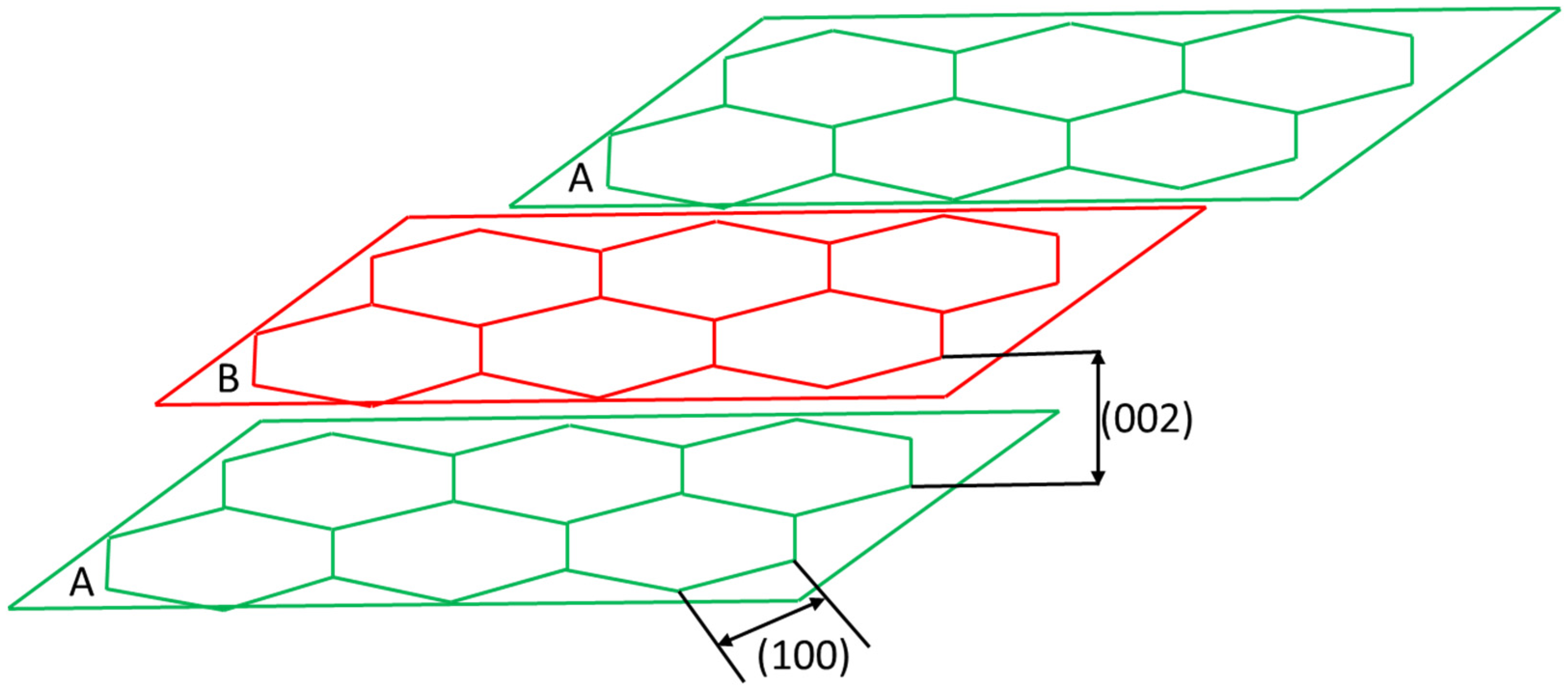
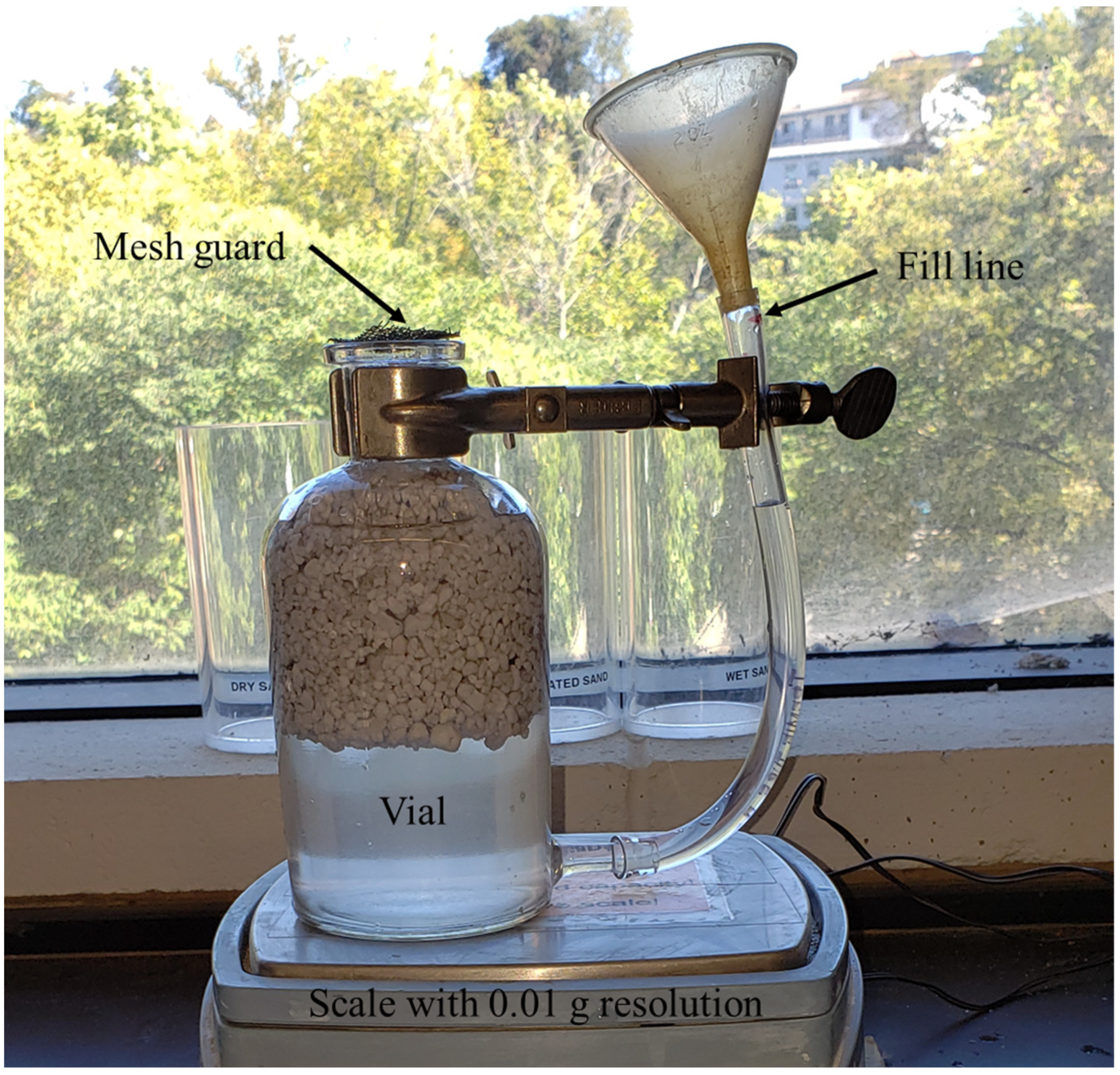
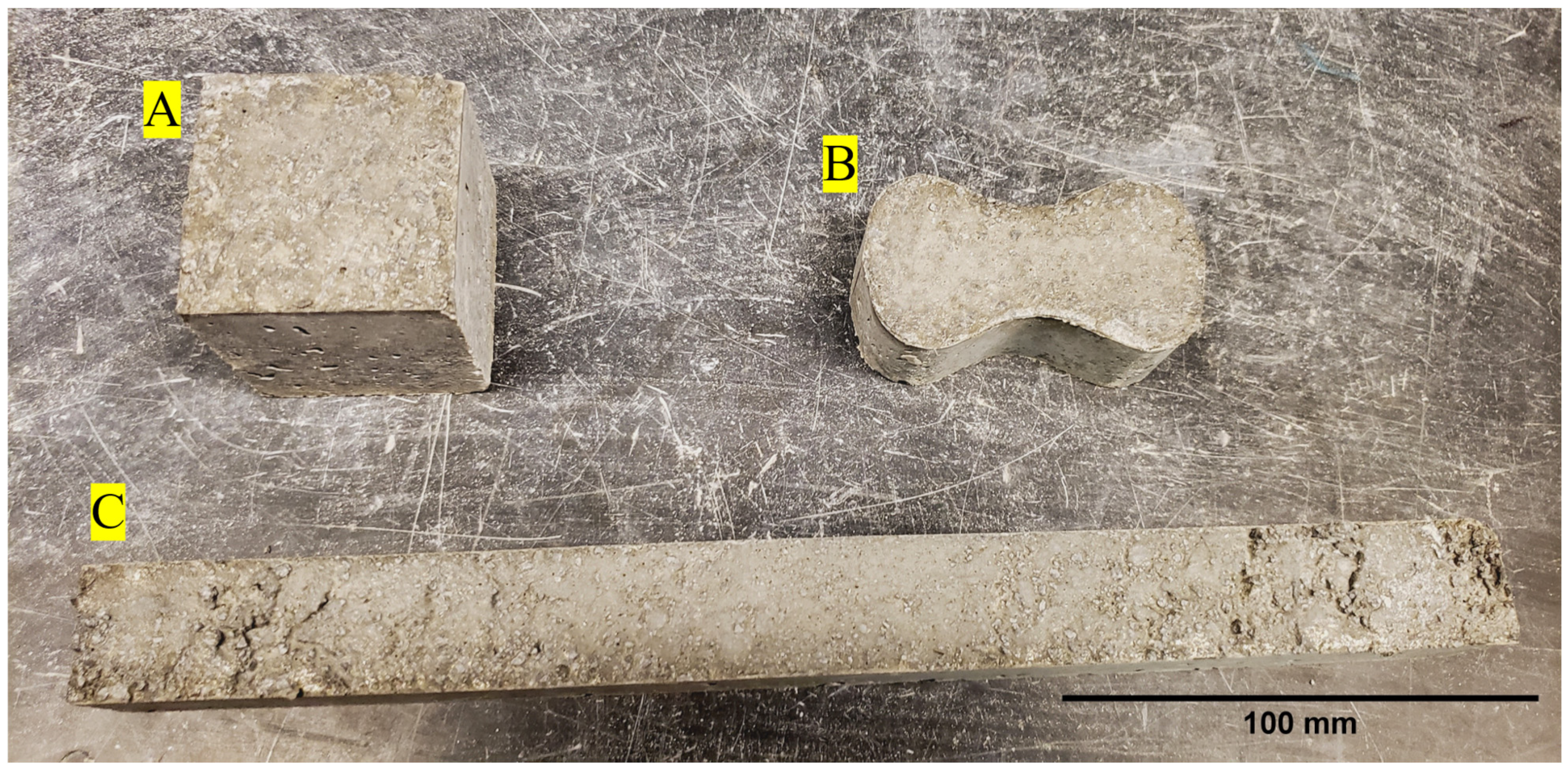
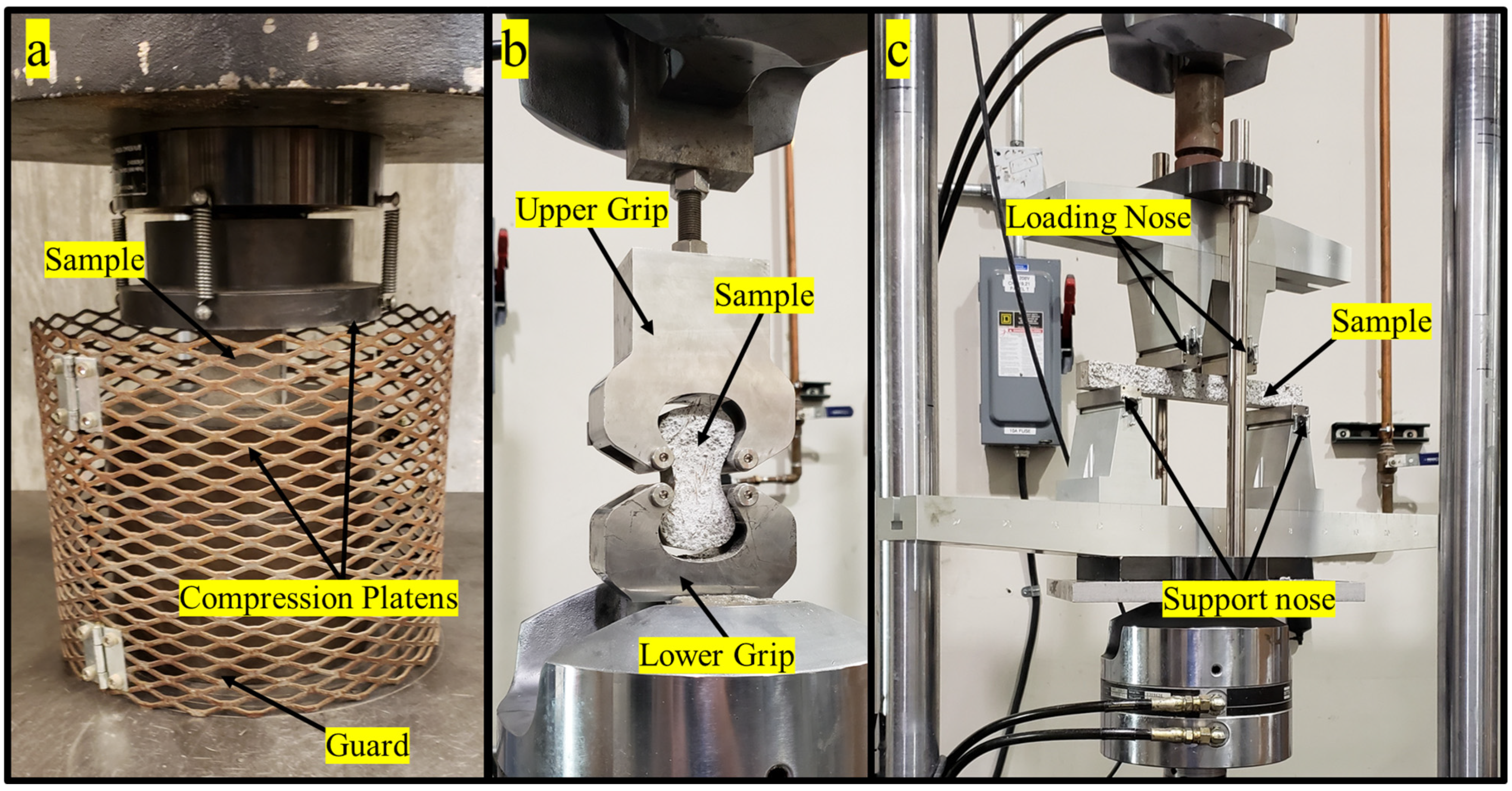
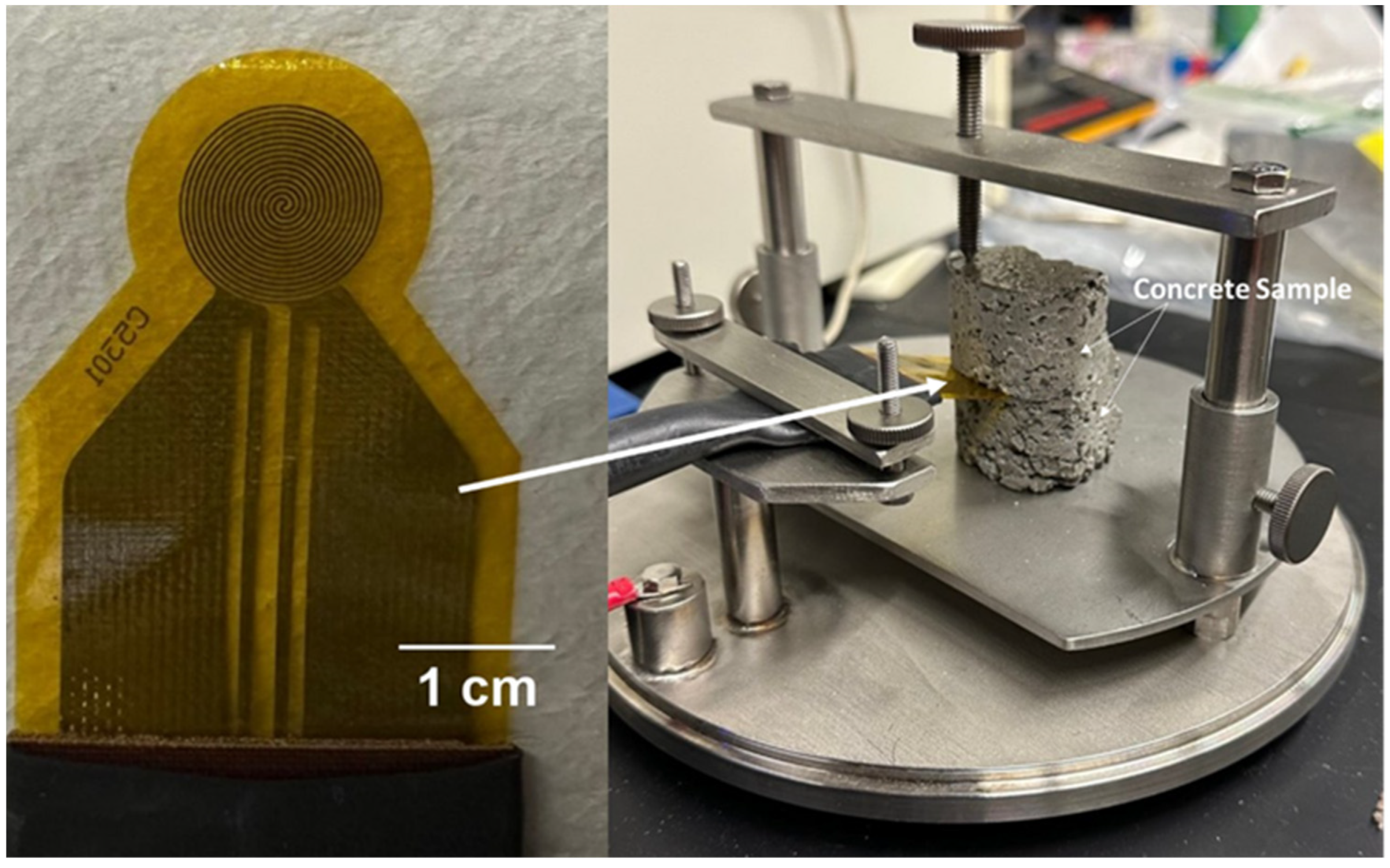

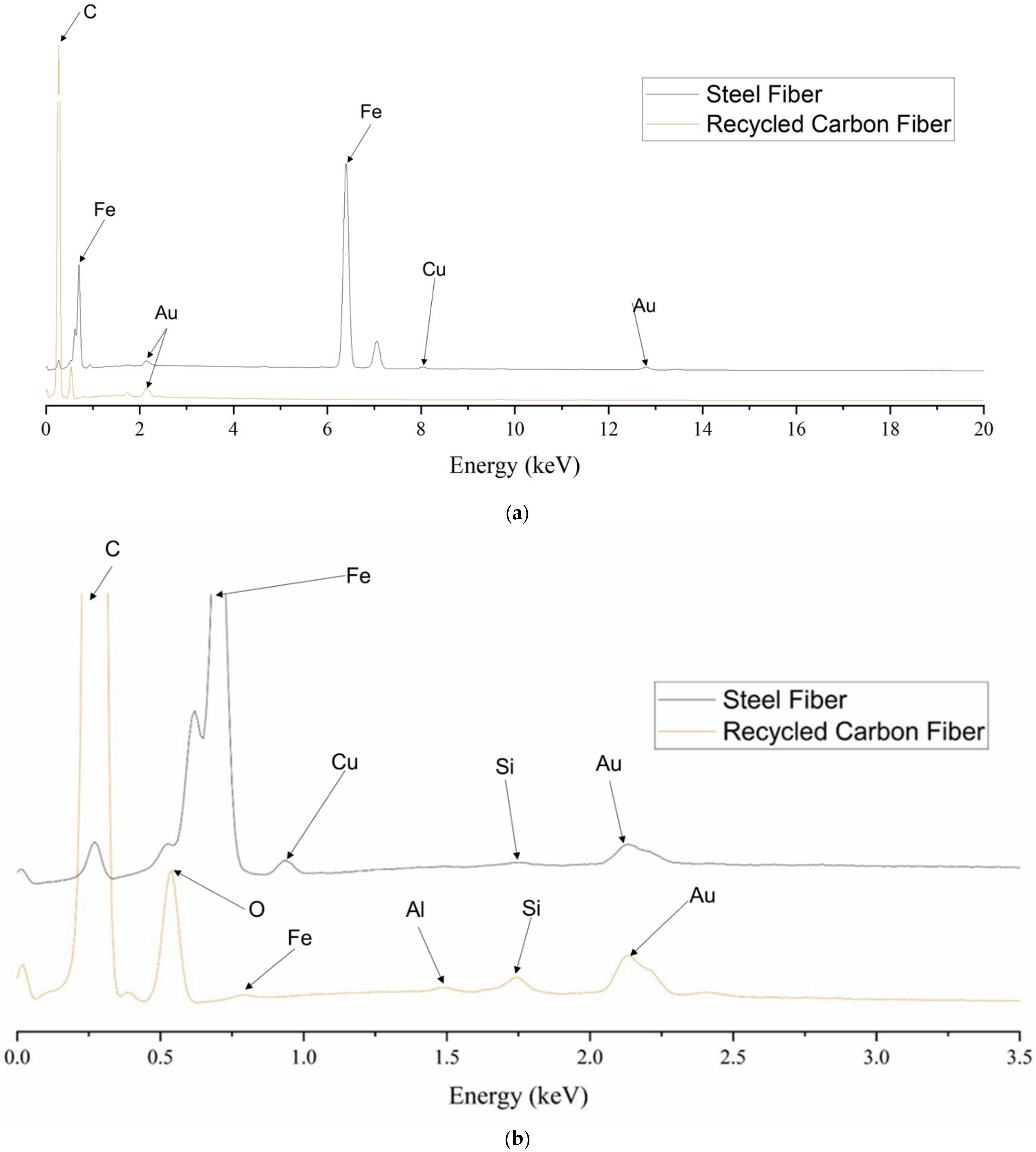

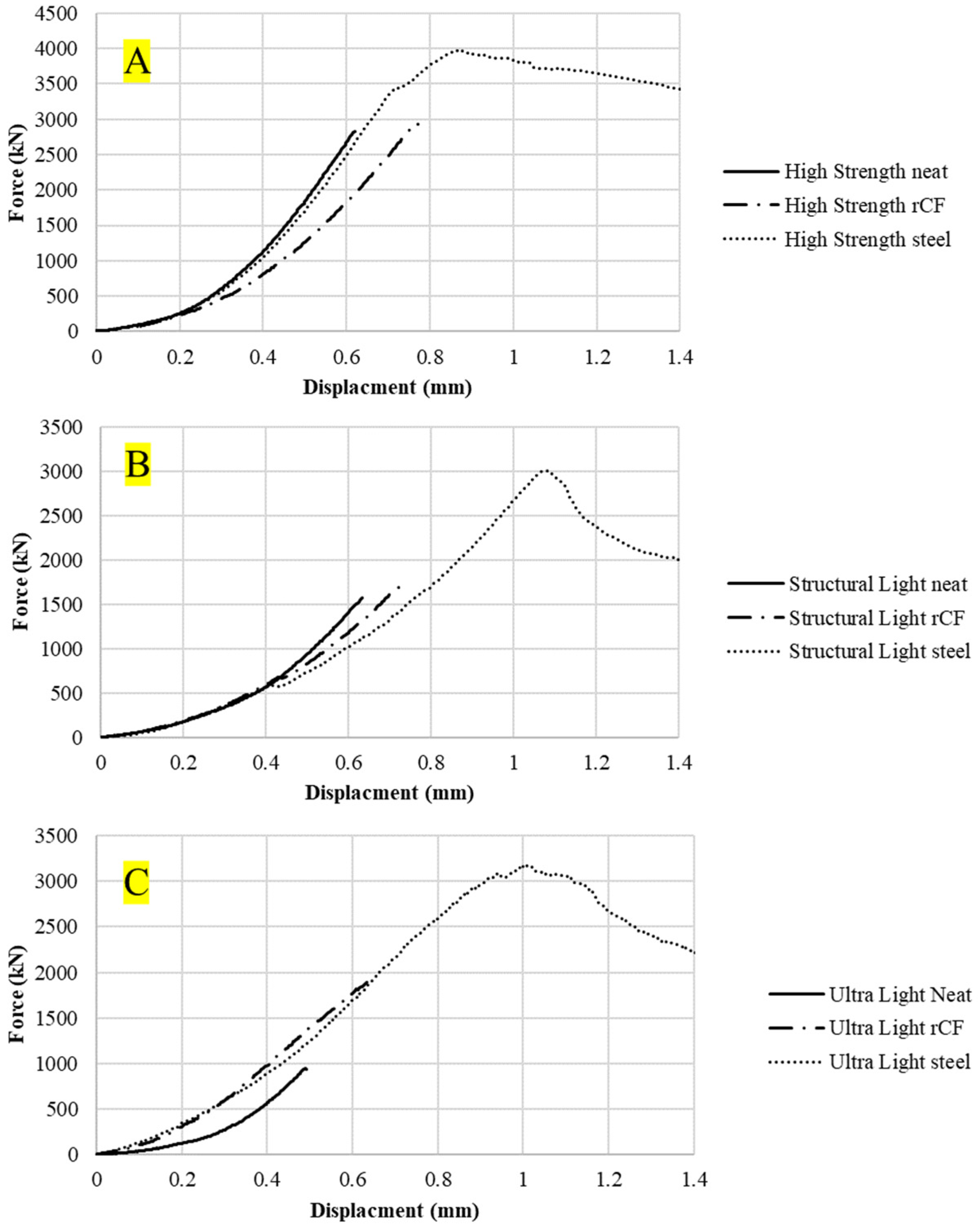
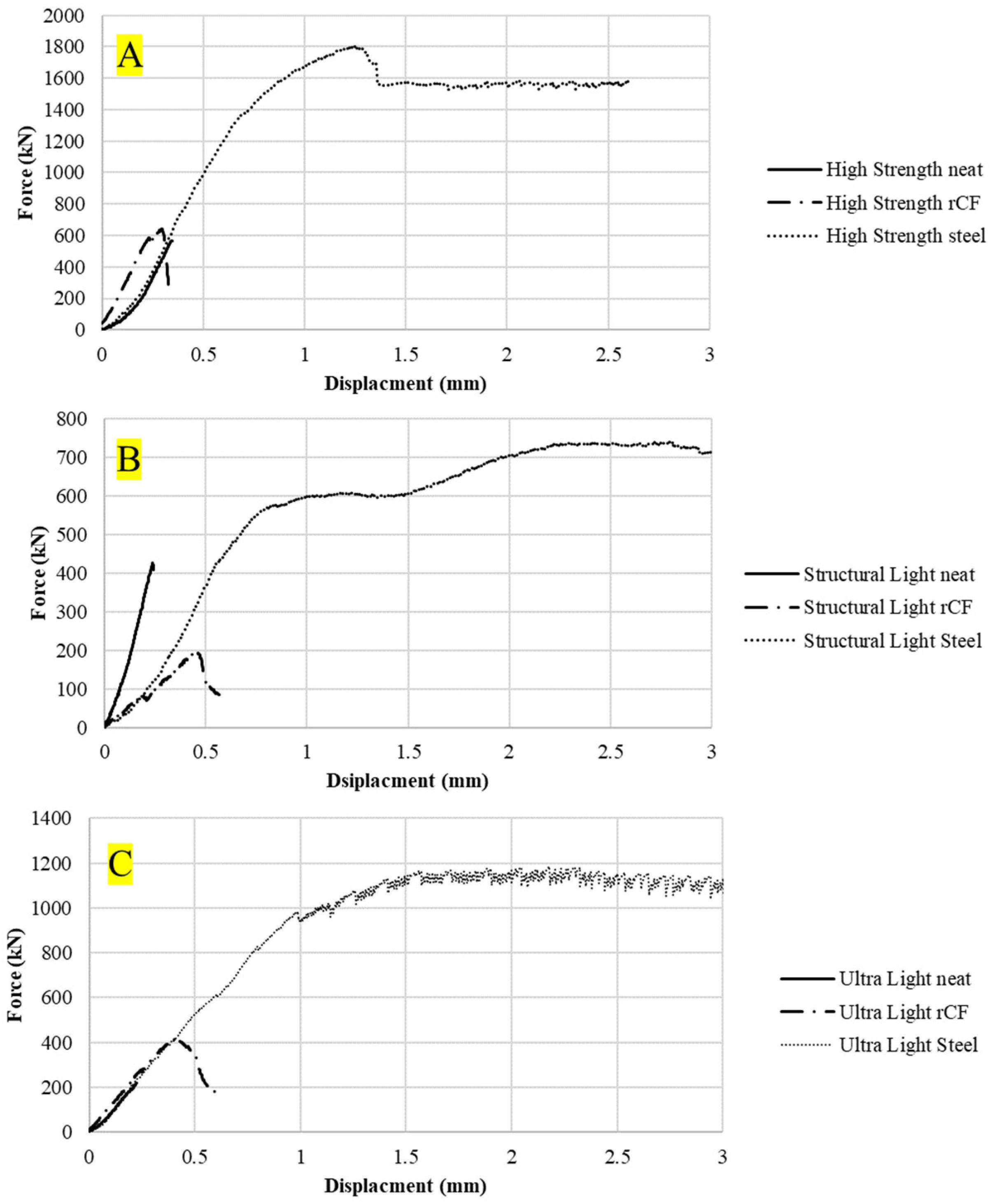


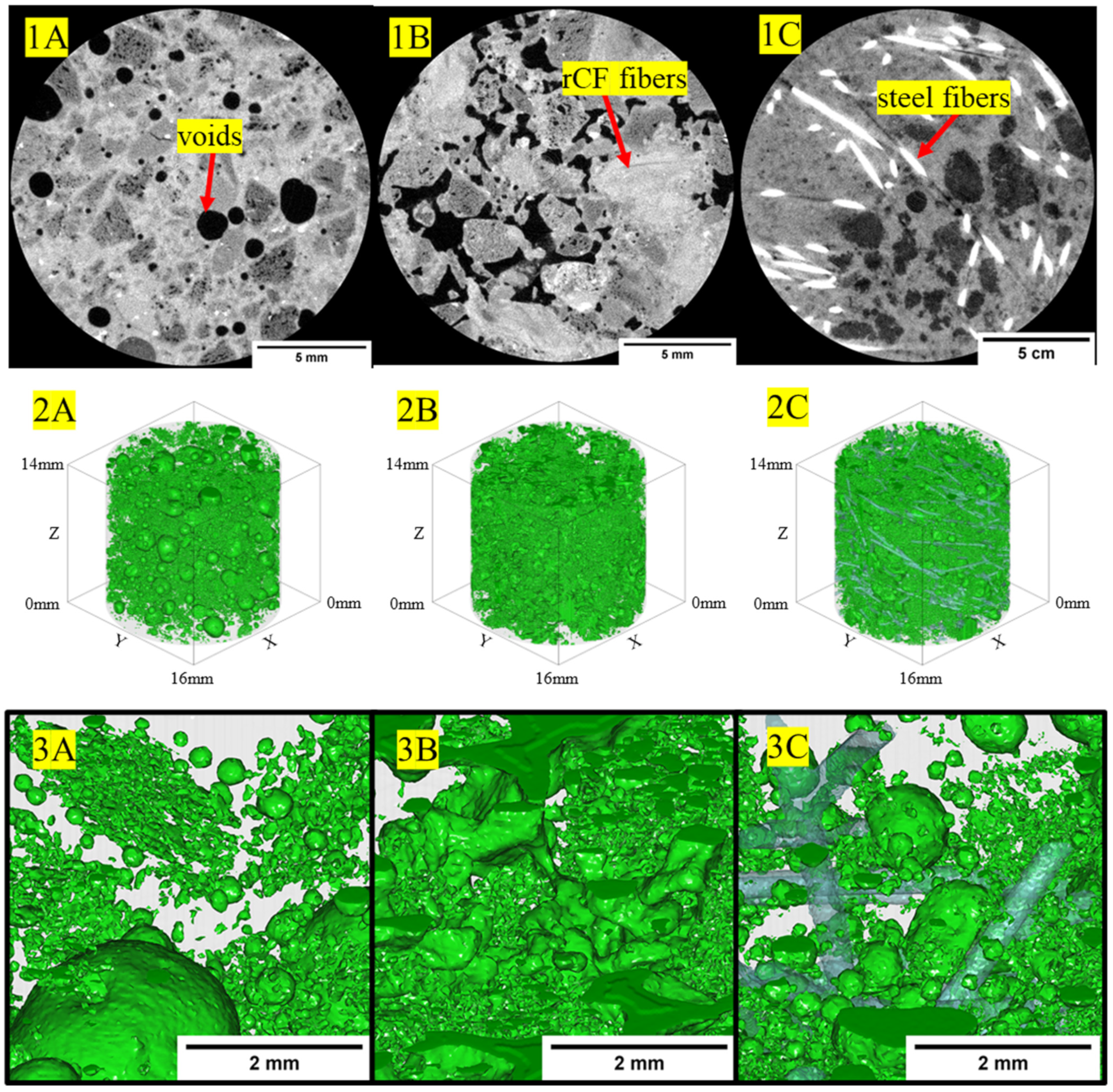
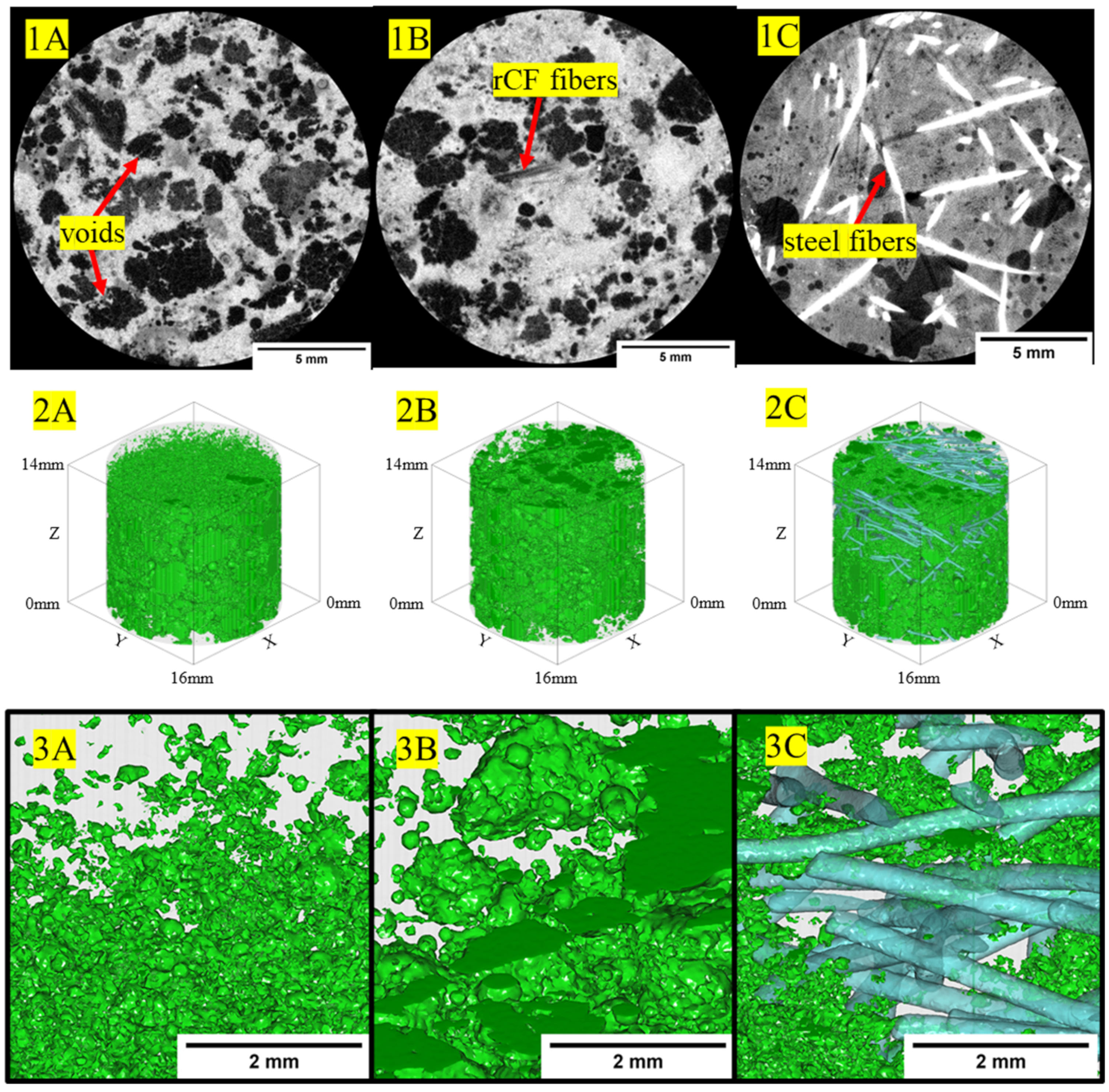
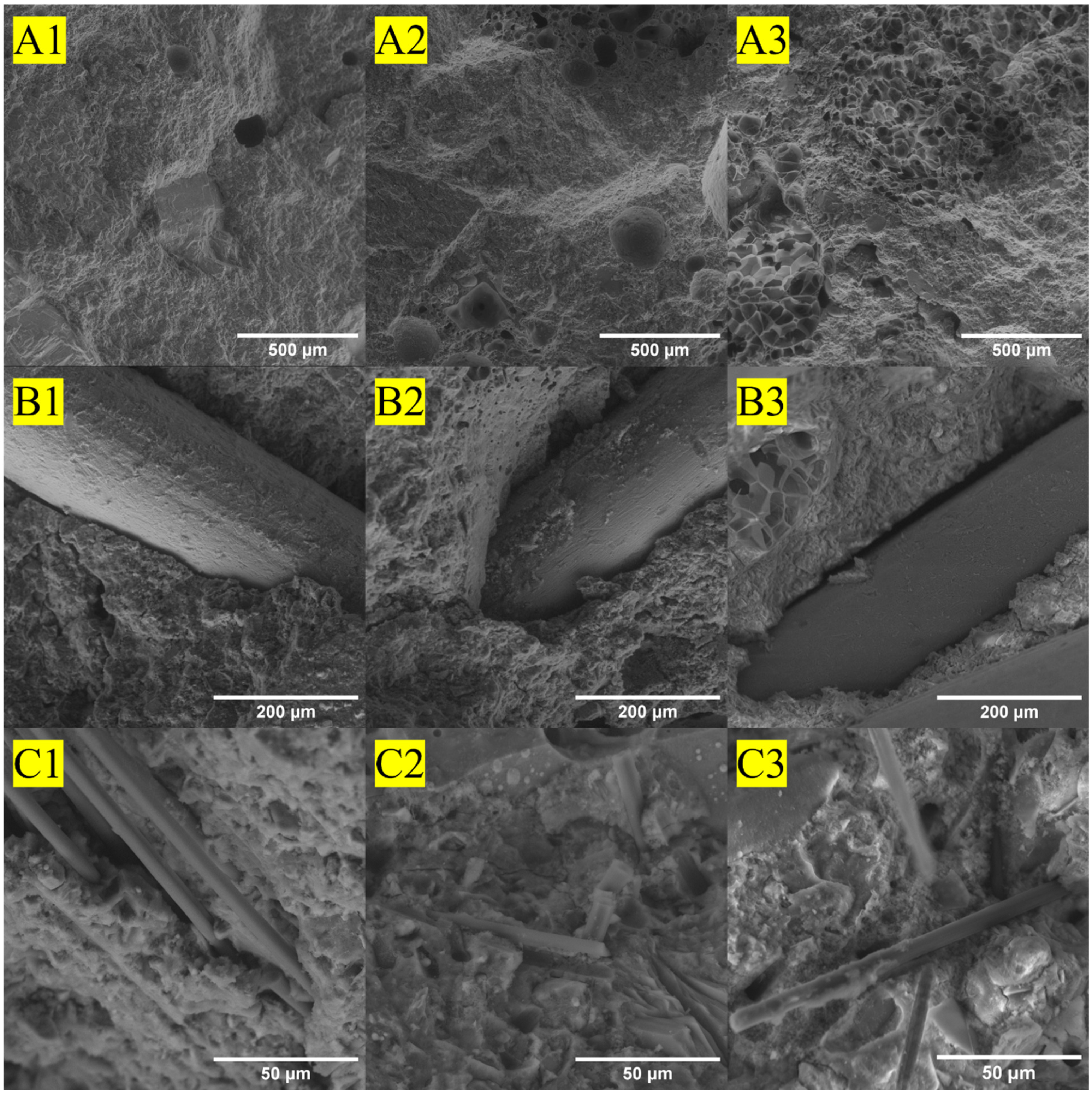
| Fiber Type | Standard | Density (g/cm3) | Fiber Length (mm) | Diameter (µm) | Aspect Ratio |
|---|---|---|---|---|---|
| Steel fiber | ASTM A820 Type 1 [116] | 7.8 [117] | 13 | 200 | 65 |
| Recycled carbon fiber (±SD) | - | 1.81 | 1.5 ± 1.2 | 6.7 ± 0.8 | 224 |
| Mix | Fiber Type | Manufactured Sand (kg/m3) | Type I Portland Cement (kg/m3) | Silica Fume (kg/m3) | Water (kg/m3) | HRWR (kg/m3) | Fibers (kg/m3) |
| High-strength | rCF | 1077 | 851 | 67 | 275 | 6.9 | 36 |
| Steel | 1077 | 851 | 67 | 275 | 6.9 | 156 | |
| None | 1131 | 851 | 67 | 275 | 6.9 | 0 | |
| Fiber Type | Stalite (kg/m3) | Type I Portland Cement (kg/m3) | Silica Fume (kg/m3) | Water (kg/m3) | HRWR (kg/m3) | Fibers (kg/m3) | |
| Structural-light | rCF | 901 | 567 | 44 | 242 | 4.6 | 36 |
| Steel | 901 | 567 | 44 | 242 | 4.6 | 156 | |
| None | 931 | 567 | 44 | 244 | 4.6 | 0 | |
| Fiber Type | Perlite (kg/m3) | Type I Portland Cement (kg/m3) | Silica Fume (kg/m3) | Water (kg/m3) | HRWR (kg/m3) | Fibers (kg/m3) | |
| Ultra-light | rCF | 119 | 851 | 67 | 350 | 6.9 | 36 |
| Steel | 119 | 851 | 67 | 350 | 6.9 | 156 | |
| None | 125 | 851 | 67 | 353 | 6.9 | 0 |
| Mechanical Testing Type | ASTM Testing Standard | Number of Samples per Concrete Type (High-Strength, Structural-Light, Ultra-Light) |
|---|---|---|
| Compression | ASTM C109 [128] | 3 |
| Tension | ASTM C307 [129] | 3 |
| Flexural | ASTM C947 [131] | 4 |
| Fiber ID | 002 Peak | 100 Peak Position | Crystalline Parameters | |||||
|---|---|---|---|---|---|---|---|---|
| 2θ (o) | FWHM (o) | d-Spacing (Å) | 2θ (o) | FWHM (o) | d-Spacing (Å) | Lc (Å) | La (Å) | |
| rCF-1 | 25.67 | 5.07 | 3.47 | 44.11 | 5.48 | 2.05 | 14.9 | 33.8 |
| rCF-2 | 24.42 | 4.76 | 3.64 | 42.74 | 5.70 | 2.11 | 14.3 | 35.9 |
| T700 | 25.19 | 4.68 | 3.53 | 43.33 | 4.14 | 2.09 | 19.7 | 36.5 |
| Material | Fiber Type | Compression (MPa) | Tension (MPa) | Flexural (MPa) | Flow | Density (g/cm3) |
|---|---|---|---|---|---|---|
| High-strength | rCF | 77.0 ± 1.2 (n = 3) | 4.55 ± 0.31 (n = 3) | 9.40 ± 0.82 (n = 4) | 25.00% | 2.22–2.24 (n = 2) |
| steel | 88.1 ± 0.8 (n = 3) | 6.43 ± 0.58 (n = 3) | 24.28 ± 1.06 (n = 4) | 150+% | 2.33–2.39 (n = 2) | |
| neat | 90.7 ± 8.3 (n = 3) | 4.52 ± 0.39 (n = 3) | 7.61 ± 1.11 (n = 4) | 150+% | 2.34–2.35 (n = 2) | |
| Structural- light | rCF | 28.4 ± 0.1 (n = 3) | 2.90 ± 0.14 (n = 3) | 2.57 ± 0.60 (n = 4) | N/A * | 1.51–1.54 (n = 2) |
| steel | 35.0 ± 9.6 (n = 3) | 4.77 ± 0.45 (n = 3) | 10.02 ± 1.46 (n = 4) | 20.3% | 1.78–1.80 (n = 2) | |
| neat | 61.2 ± 2.9 (n = 3) | 2.50 ± 0.24 (n = 3) | 6.20 ± 0.88 (n = 4) | 84.4% | 1.66–1.74 (n = 2) | |
| Ultra-light | rCF | 21.7 ± 0.6 (n = 3) | 3.21 ± 0.17 (n = 3) | 5.62 ± 1.10 (n = 4) | 1.60% | 1.47–1.49 (n = 2) |
| steel | 41.4 ± 0.7 (n = 3) | 5.87 ± 1.31 (n = 3) | 16.32 ± 2.62 (n = 4) | 150+% | 1.57–1.79 (n = 2) | |
| neat | 24.9 ± 5.3 (n = 3) | 1.50 ± 0.13 (n = 3) | 3.42 ± 0.84 (n = 4) | 150+% | 1.50–1.52 (n = 2) |
| Concrete Type | Neat or Reinforcement Type | Void Volume Fraction (%) |
|---|---|---|
| High-strength | Neat | 0.9 |
| Steel | 1.4 | |
| rCF | 4.7 | |
| Structural-light | Neat | 12.2 |
| Steel | 14.9 | |
| rCF | 16.2 | |
| Ultra-light | Neat | 37.1 |
| Steel | 30.1 | |
| rCF | 27.7 |
| Concrete Type | Neat or Reinforcement Type | Thermal Conductivity (W/mK) |
|---|---|---|
| High-strength | Neat | 1.666 (0.011) |
| Steel | 1.787 (0.004) | |
| rCF | 1.502 (0.027) | |
| Structural-light | Neat | 0.752 (0.012) |
| Steel | 0.945 (0.024) | |
| rCF | 0.551 (0.018) | |
| Ultra-light | Neat | 0.341 (0.003) |
| Steel | 0.515 (0.032) | |
| rCF | 0.535 (0.010) |
Disclaimer/Publisher’s Note: The statements, opinions and data contained in all publications are solely those of the individual author(s) and contributor(s) and not of MDPI and/or the editor(s). MDPI and/or the editor(s) disclaim responsibility for any injury to people or property resulting from any ideas, methods, instructions or products referred to in the content. |
© 2023 by the authors. Licensee MDPI, Basel, Switzerland. This article is an open access article distributed under the terms and conditions of the Creative Commons Attribution (CC BY) license (https://creativecommons.org/licenses/by/4.0/).
Share and Cite
Patchen, A.; Young, S.; Goodbred, L.; Puplampu, S.; Chawla, V.; Penumadu, D. Lower Carbon Footprint Concrete Using Recycled Carbon Fiber for Targeted Strength and Insulation. Materials 2023, 16, 5451. https://doi.org/10.3390/ma16155451
Patchen A, Young S, Goodbred L, Puplampu S, Chawla V, Penumadu D. Lower Carbon Footprint Concrete Using Recycled Carbon Fiber for Targeted Strength and Insulation. Materials. 2023; 16(15):5451. https://doi.org/10.3390/ma16155451
Chicago/Turabian StylePatchen, Andrew, Stephen Young, Logan Goodbred, Stephen Puplampu, Vivek Chawla, and Dayakar Penumadu. 2023. "Lower Carbon Footprint Concrete Using Recycled Carbon Fiber for Targeted Strength and Insulation" Materials 16, no. 15: 5451. https://doi.org/10.3390/ma16155451





